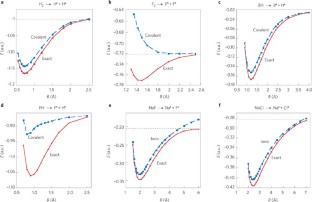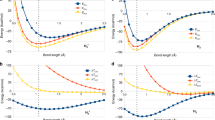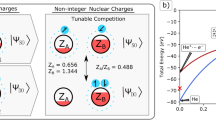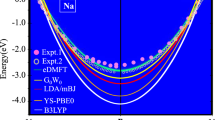Abstract
Electron-pair bonding is a central chemical paradigm. Here, we show that alongside the two classical covalent and ionic bond families, there exists a class of charge-shift (CS) bonds wherein the electron-pair fluctuation has the dominant role. Charge-shift bonding shows large covalent–ionic resonance interaction energy, and depleted charge densities, and features typical to repulsive interactions, albeit the bond itself may well be strong. This bonding type is rooted in a mechanism whereby the bond achieves equilibrium defined by the virial ratio. The CS bonding territory involves, for example, homopolar bonds of compact electronegative and/or lone-pair-rich elements, heteropolar bonds of these elements among themselves and with other atoms (for example, the metalloids, such as silicon and germanium), hypercoordinated molecules, and bonds whose covalent components are weakened by exchange-repulsion strain (as in [1.1.1]propellane). Here, we discuss experimental manifestations of CS bonding in chemistry, and outline new directions demonstrating the portability of the new concept.
This is a preview of subscription content, access via your institution
Access options
Subscribe to this journal
Receive 12 print issues and online access
$259.00 per year
only $21.58 per issue
Buy this article
- Purchase on Springer Link
- Instant access to full article PDF
Prices may be subject to local taxes which are calculated during checkout



Similar content being viewed by others
References
Lewis, G. N. The atom and the molecule. J. Am. Chem. Soc. 38, 762–785 (1916).
Heitler, W. & London, F. Wechselwirkung neutraler atome un homöopolare bindung nach der quantenmechanik. Zeits. für Physik. 44, 455–472 (1927).
Pauling, L. The Nature of the Chemical Bond (Cornell Univ. Press, 1939).
London, F. Zur quantentheorie der homöopolaren valenzzahlen. Zeits. für Physik A 46, 455–477 (1928).
Shaik, S., Danovich, D., Silvi, B., Lauvergnat, D. & Hiberty, P. C. Charge-shift bonding – a class of electron-pair bonds that emerges from valence bond theory and is supported by the electron localization function approach. Chem. Eur. J. 11, 6358–6371 (2005).
Bader, R. F. W. & Nguyen-Dang, T. T. Quantum theory of atoms in molecules–Dalton revisited. Adv. Quant. Chem. 14, 63–124 (1981).
Henn, J., Ilge, D., Leusser, D., Stalke, D. & Engles, D. On the accuracy of theoretically and experimentally determined electron densities of polar bonds. J. Phys. Chem. A 108, 9442–9452 (2004).
Apeloig, Y. in The Chemistry of Organic Silicon Compounds Vol. 1 (eds Apeloig, Y. & Rappoport, Z.) Ch. 2 (Wiley, 1989).
Apeloig, Y. & Stanger, A. The first demonstration of solvolytic generation of a simple silicenium ion (R3Si+). Access via 1,2-methyl migration. J. Am. Chem. Soc. 109, 272–273 (1987).
Prakash, G. K. S. et al. Triphenylsilyl perchlorate revisited: 29Si and 35Cl NMR spectroscopy and X-ray crystallography showing covalent nature in both solution and the solid state. Difficulties in observing long-lived silyl cations in the condensed state. J. Am. Chem. Soc. 109, 5123–5126 (1987).
Zhang, L., Ying, F., Wu, W., Hiberty, P. C. & Shaik, S. Topology of electron charge density for chemical bonds from valence bond theory: a probe of bonding types. Chem. Eur. J. 15, 2979–2989 (2009).
Shaik, S., Maitre, P., Sini, G. & Hiberty, P. C. The charge-shift bonding concept. Electron-pair bonds with very large ionic-covalent resonance energies. J. Am. Chem. Soc. 114, 7861–7866 (1992).
Lauvergnat, D., Hiberty, P. C., Danovich, D. & Shaik, S. Comparison of C-Cl and Si-Cl bonds. A valence bond study. J. Phys. Chem. 100, 5715–5720 (1996).
Shurki, A., Hiberty, P. C. & Shaik, S. Charge-shift bonding in group IVB halides: a valence bond study of MH3-Cl (M = C, Si, Ge, Sn, Pb) molecules. J. Am. Chem. Soc. 121, 822–834 (1999).
Galbraith, J. M., Blank, E., Shaik, S. & Hiberty, P. C. π-bonding in second and third row molecules: testing the strength of Linus's blanket. Chem. Eur. J. 6, 2425–2434 (2000).
Hiberty, P. C., Megret, C., Song, L., Wu, W. & Shaik, S. Barriers of hydrogen abstraction vs halogen exchange: an experimental manifestation of charge-shift bonding. J. Am. Chem. Soc. 128, 2836–2843 (2006).
Su, P., Song, L., Wu, W., Shaik, S. & Hiberty, P. C. Heterolytic bond dissociation in water: why is it so easy for C4H9Cl but not for C3H9SiCl? J. Phys. Chem. A 112, 2988–2997 (2008).
Wu, W., Gu, J., Song, J., Shaik, S. & Hiberty, P. C. The inverted bond in [1.1.1]propellane is a charge-shift bond. Angew. Chem. Int. Ed. 48, 1407–1410 (2009).
Bader, R. F. W. Atoms in Molecules: A Quantum Theory (Oxford Univ. Press, 1990).
Silvi, B. & Savin, A. Classification of chemical bonds based on topological analysis of electron localization functions. Nature 371, 683–686 (1994).
Coppens, P. Charge densities come of age. Angew. Chem. Int. Ed. 44, 6810–6811 (2005).
Coppens, P. X-ray Densities and Chemical Bonding (Oxford Univ. Press, 1997).
Kraka, E. & Cremer, D. in Theoretical Models of Chemical Bonding Part 2 (ed. Maksić, Z. B.) 457–543 (Springer, 1990).
Silvi, B. The spin-pair compositions as local indicators of the nature of the bonding. J. Phys. Chem. A 107, 3081–3085 (2003).
Messershmidt, M. et al. Electron density and bonding at inverted carbon atoms: an experimental study of a [1.1.1]propellane derivative. Angew. Chem. Int. Ed. 44, 3925–3928 (2005).
Polo, V., Andres, J. & Silvi, B. New insight on the bridge carbon-carbon bond in propellanes: a theoretical study based on the analysis of the electron localization function. J. Comput. Chem. 28, 857–864 (2007).
Lusar, R., Beltrán, A., Andrés, J., Noury, S. & Silvi, B. Topological analysis of electron density in depleted homopolar chemical bonds. J. Comput. Chem. 20, 1517–1526 (1999).
Rincon, L. & Almeida, R. On the topology of the electron charge density at the bond critical point of the electron-pair bond. J. Phys. Chem. A 102, 9244–9254 (1998).
Kitaura, K. & Morokuma, K. A new energy decomposition scheme for molecular interactions within the Hartree-Fock approximation. Int. J. Quantum Chem. 10, 325–340 (1976).
Ziegler, T. & Rauk, A. On the calculation of bonding energies by the Hartree-Fock-Slater method. Theor. Chim. Acta 46, 1–10 (1977).
Velde, G. T. et al. Chemistry with ADF. J. Comput. Chem. 22, 931–967 (2001).
Krapp, A., Bickelhaupt, F. M. & Frenking, G. Orbital overlap and chemical bonding. Chem. Eur. J. 12, 9196–9216 (2006).
Hiberty, P. C., Ramozzi, R., Song, L., Wu, W. & Shaik. S. The physical origin of large covalent-ionic resonance energies in some two-electron bonds. Faraday Discuss. 135, 261–272 (2006).
Kutzelnigg, W. in Theoretical Models of Chemical Bonding Part 2 (ed. Maksić, Z. B.) 1–44 (Springer, 1990).
Ruedenberg, K. The physical nature of the chemical bond. Rev. Mod. Phys. 34, 326–376 (1962).
Feinberg, M. J. & Ruedenberg, K. Paradoxical role of the kinetic-energy operator in the formation of the covalent bond. J. Chem. Phys. 54, 1495–1591 (1971).
Wilson, C. Q. & Goddard, W. A. III. The role of kinetic energy in chemical binding. Theor. Chim. Acta. 26, 195–210 (1972).
Rozendaal, A. & Baerends, E. J. A momentum-space view of the chemical bond. I The first-row homonuclear diatomics. Chem. Phys. 95, 57–91 (1985).
Ruedenberg, K. & Schmidt, M. Why does electron sharing lead to covalent bonding? A variational analysis. J. Comput. Chem. 28, 391–410 (2007).
Bickelhaupt, F. M. & Baerends, E. J. Kohn-Sham density functional theory: predicting and understanding chemistry. Rev. Comput. Chem. 15, 1–86 (2000).
Sanderson, R. T. Polar Covalence (Academic Press, 1983).
Messerschmidt, M., Wagner, A., Wong, M. W. & Luger, P. Atomic properties of N2O4 based on its experimental charge density. J. Am. Chem. Soc. 124, 732–733 (2002).
Dunitz, J. D. & Seiler, P. The absence of bonding electron density in certain covalent bonds as revealed by X-ray analysis. J. Am. Chem. Soc. 105, 7056–7058 (1983).
Dunitz, J. D., Schweizer, W. B. & Seiler, P. X-ray study of the deformation density in tetrafluoroterephthalodinitrile: weak bonding density in the C-F bond. Helv. Chem. Acta 66, 123–133 (1983).
Coppens, P., Yang, Y. W., Blessing, R. H., Cooper, W. F. & Larsen, F. K. The experimental charge distribution in sulfur containing molecules. Analysis of cyclic octasulfur at 300 and 100 K. J. Am. Chem. Soc. 99, 760–766 (1977).
Savariault, J.-M. & Lehmann, M. S. Experimental determination of the deformation electron density in hydrogen peroxide by combination of X-ray and neutron diffraction measurements. J. Am. Chem. Soc. 102, 1298–1303 (1980).
Ruedenberg, K. & Schwarz, W. H. E. Nonspherical atomic ground state densities and chemical deformation densities from x-ray scattering. J. Chem. Phys. 92, 4956–4969 (1990).
Gomes de Mesquita, A. H., MacGillavry C. H. & Eriks, K. The structure of triphenylmethyl perchlorate at 85°C. Acta Crystallogr. 18, 437–443 (1965).
Kim, K.-C. et al. Crystallographic evidence for a free silylium ion. Science 297, 825–827 (2002).
Ploshnik, E. The Triple Bond – A Valence Bond Theory Point Of View MSc Thesis, Hebrew Univ. (2005).
Kost, D. & Kalikhman, I. Hypercoordinate silicon complexes based on hydrazine ligands. A remarkably flexible molecular system. Acc. Chem. Res. 42, 303–314 (2009).
Dávalos, J. Z., Herrero, R., Abboud, J.-L. M., Mó, O. & Yáñez, M. How can carbon be covalently bound to five ligands? The case of Si2(CH3)7 . Angew. Chem. Int. Ed. 46, 381–385 (2007).
Fernández, I., Uggerud, E. & Frenking, G. Stable pentacoordinate carbocations: structure and bonding. Chem. Eur. J. 13, 8620–8626 (2007).
Panisch, R., Bolte, M. & Müller, T. Hydrogen and fluorine-bridged disilyl cations and their use in catalytic C-F activation. J. Am. Chem. Soc. 128, 9676–9682 (2006).
Llusar, R., Beltran, A., Andrés, J., Fuster, F. & Silvi, B. Topological analysis of multiple metal-metal bonds in dimers of the M2(formamidinate)4 type with N = Nb, Mo, Tc, Ru, Rh, and Pd. J. Phys. Chem. A 105, 9460–9466 (2001).
Shaik, S. in Molecules in Natural Science and Medicine: An Encomium for Linus Pauling (eds Maksić, Z. B. & Eckert-Maksić, M.) 253–266 (Ellis Horwood, 1991).
Cho, K. B., Carvajal, M. A. & Shaik, S. First half-reaction mechanisms of nitric oxide. The role of proton and oxygen coupled electron transfers in the reaction by quantum mechanical/ molecular mechanical calculations. J. Phys. Chem. B 113, 336–346 (2009).
Grochala, W., Hoffmann, R., Feng, J. & Ashcroft, N. W. The chemical imagination at work in very tight places. Angew. Chem. Int. Ed. 46, 3620–3642 (2007).
Dognon, J.-P., Clavaguéra C. & Pyykkö, P. A predicted organometallic series following a 32-electron principle: An@C28 (An=Th, Pa+, U2+, Pu4+). J. Am. Chem. Soc. 131, 238–243 (2009).
Rupar, P., Staroverov, V. N. & Baines, K. M. A cryptand-encapsulated germanium(II) dication. Science 322, 1360–1363 (2008).
Author information
Authors and Affiliations
Corresponding authors
Rights and permissions
About this article
Cite this article
Shaik, S., Danovich, D., Wu, W. et al. Charge-shift bonding and its manifestations in chemistry. Nature Chem 1, 443–449 (2009). https://doi.org/10.1038/nchem.327
Published:
Issue Date:
DOI: https://doi.org/10.1038/nchem.327
This article is cited by
-
First-Principles Calculation of CaO–Al2O3–CaF2 Slag
Metallurgical and Materials Transactions B (2024)
-
Anions featuring an aluminium–silicon core with alumanyl silanide and aluminata-silene characteristics
Nature Chemistry (2023)
-
Nonclassical tetracoordinate carbon in exohedral complexes of hexaprismanes X12H12Cn (X = C, Si, Ge; n = 1–3)
Russian Chemical Bulletin (2023)
-
Collective interactions among organometallics are exotic bonds hidden on lab shelves
Nature Communications (2022)
-
Can a chemical bond be exclusively covalent or ionic?
Journal of Chemical Sciences (2022)



